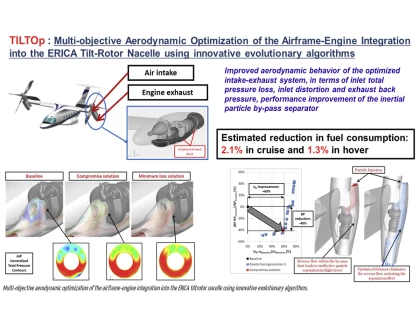
Background
Civil tiltrotors are expected to play an important role in future regional transport due to their particular characteristics, combining the advantages of helicopters’ vertical and hover capabilities (with reduced requirements for ground infrastructure) with those of fixed-wing aircraft cruise speed and range.
To this purpose, the entire rotor, transmission and engine nacelles must be able to tilt by about 90 degrees around an axis passing through the vehicle wings. Engine nacelles, which are relatively large in dimensions and weight, are positioned at the external part of the wings, in order to provide best maneuverability and minimize interference with the lifting wings, especially in helicopter mode. A further development of this concept consists in the ERICA advanced tiltrotor vehicle, where the outboard part of the wing is able itself to tilt, thereby reducing the downward thrust of the rotor blades on the wing in helicopter mode.
Engine nacelle/wing integration is therefore peculiar to tiltrotors and requires careful design as it significantly impacts the overall vehicle drag. Reduction of both internal and external nacelle aerodynamic drag can be achieved by means of a proper inlet/exhaust duct design.
Strategy
In TILTOp, an in-house multi-objective evolutionary algorithm developed jointly at University of Padova and HIT09 (namely GeDEA) was used, coupled with both commercial and open-source CFD solvers, to drive the optimal design of tiltrotor nacelle intake and exhausts. Specifically, the intake performance was enhanced by reducing the total pressure losses and the inlet flow distortion at the engine interface. Reduction in the backpressure was instead considered as the main goal of the exhaust optimization. In addition, the inlet particle separator efficiency was taken into account as well, especially in hover flight.
Outcomes
The optimized intake featured remarkable improvements in the performance parameters, being characterized by a 51% reduction in total pressure loss and a 36% reduction in total pressure distortion in cruise forward flight with respect to the reference configuration, without significant increase in the nacelle weight or drag.
Regarding the exhaust, the design optimization carried out in TILTOp made it possible to remove the by-pass back flow issue which characterized the original configuration at low speed flight conditions. This eliminated the risk of re-ingestion of combustion gases through the intake and greatly increased the inertial particle separator efficiency for both hover and conversion modes. As a consequence, an enhancement of the propulsion system global safety was achieved since the probability of FOD damages was reduced. Engine back pressure was lowered by 35% with respect to the baseline configuration, providing a consequent reduction in the engine fuel consumption for the given level of power required.
The results of intake optimization carried out in TILTOp were assessed experimentally in a subsequent project, called TETRA, coordinated by Politecnico di Milano. A 1:2.5 nacelle scaled model was manufactured and tested at the Politecnico di Milano wind tunnel in various operating conditions.
The comparison of the baseline and optimised intake configurations confirmed the effectiveness of the optimised geometry in terms of reduction of the average total pressure drop and flow distortion at AIP. This benefit was found both for cruise and conversion conditions, thus indicating the suitability of the geometry optimisation also out of the design flight conditions.
Duration: July 2010-December 2011
This project has received funding from the Clean Sky Joint Undertaking (JU) under grant agreement No. 267309






